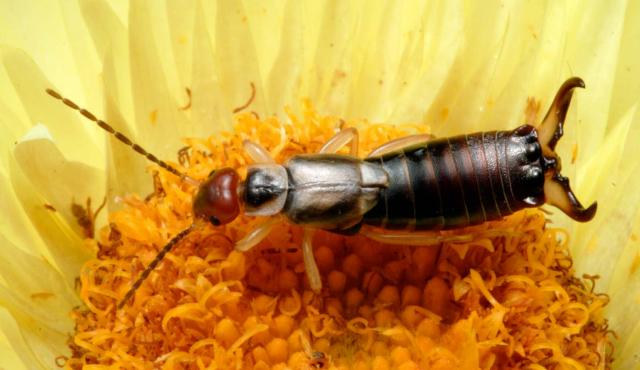A range of teacher professional learning programs will be developed to accompany the Biodiversity of the Western Volcanic Plains online outreach...

European Earwig
Forficula auricularia
Nocturnal. European Earwigs can occur in large numbers at times. They can be a pest as they damage young plants. Adults can use their pincers in defense, twisting their abdomen forward over their head or sideways to fight an enemy, often another earwig.
| Details | Description |
| Type | Invertebrate |
| Group | Insect - Earwig |
| Identifying Characteristics | |
| Distinctive Markings | A pair of long, pointed tail pincers. Dark brown body. |
| Diet | Omnivore. Eats aphids, spiders, caterpillar pupae, leaf beetle eggs, scale insects and springtails. Also eats vegetable matter including flowers, fungi and algae. |
| Habitat | Hides in leaf debris, cracks and crevices during the day. Can be found on flowers at night. |
| Native Status | Introduced |
| Taxonomy | |
| Phylum | Arthropoda |
| Class | Insecta |
| Order | Dermaptera |
| Family | Forficulidae |
| Genus | Forficula |
| Species | auricularia |

Distribution maps indicate current and historic locations where species have been sighted.
Source: Atlas of Living Australia
| Conservation Status | |
| DEPI Advisory List | Not listed |
| FFG Act | Not listed |
| EPBC Act | Not listed |
The conservation status of species is listed within Victoria and Australia.
The Department of Environment and Primary Industry (DEPI) Advisory List consists of non-statutory advisory lists of rare or threatened flora and fauna within Victoria.
The Flora and Fauna Guarantee Act 1988 (FFG Act) lists threatened species in Victoria. Under the Act, an Action Statement is produced for each listed species.
The Environment Protection and Biodiversity Conservation Act 1999 (EPBC Act) is the Australian Government’s key piece of environmental legislation, listing nationally threatened native species and ecological communities.



